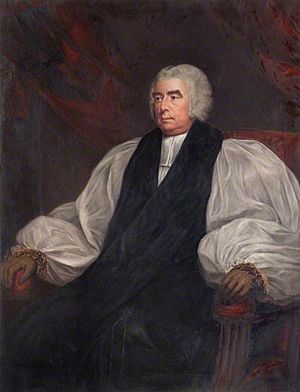Samuel Goodenough facts for kids
Quick facts for kids The Right Reverend Samuel Goodenough |
|
|---|---|
| Bishop of Carlisle | |
 |
|
| Diocese | Diocese of Carlisle |
| In Office | 1808–1827 (death) |
| Predecessor | Edward Venables-Vernon |
| Successor | Hugh Percy |
| Other posts | Dean of Rochester (1802–1808) |
| Personal details | |
| Born | 10 May 1743 Weyhill, Hampshire, England |
| Died | 12 August 1827 (aged 84) Acton Green, London, England |
| Buried | Westminster Abbey |
| Nationality | British |
| Denomination | Anglican |
| Spouse | Elizabeth Ford (m.1770) |
| Profession | Botanist, Orchidologist |
| Education | Westminster School |
| Alma mater | Christ Church, Oxford |
Samuel Goodenough (born May 10, 1743 – died August 12, 1827) was an important English church leader. He served as the Bishop of Carlisle from 1808 until he passed away in 1827. Besides his work in the church, he was also a keen amateur botanist, someone who studies plants.
Samuel Goodenough is remembered in the world of science. A group of plants called Goodenia is named after him. Also, a bird known as the red-capped robin (Petroica goodenovii) has a scientific name that honors him. Even a type of cuckoo bee, Nomada goodeniana, was named after him because of his sharp eye for insects.
Early Life and Education
Samuel Goodenough was born on April 29, 1743, in a place called Kimpton, near Weyhill in Hampshire, England. He was the third son of Reverend William Goodenough. When Samuel was seven years old, his family moved to Broughton Poggs.
He started school in Witney. Five years later, he went to Westminster School, a famous school in London. He was a very good student there. In 1760, he earned a special scholarship to study at Christ Church, Oxford University. He earned his first degree in 1764 and continued his studies, getting more degrees in 1767 and 1772.
Teaching and Family Life
After finishing his studies, Samuel Goodenough returned to Westminster School in 1766. He worked there as an under-master, helping to teach students, for four years. Later, he decided to become a church minister, following in his father's footsteps.
In 1770, he married Elizabeth Ford. Two years later, he opened his own school in Ealing. He ran this school for 26 years, teaching many children from important families.
A Passion for Plants
Even though he was a church leader and a teacher, Samuel Goodenough loved studying plants. He was known for his knowledge of classical subjects, but botany was his true passion.
When the Linnean Society was created in 1787, he was one of the people who helped set it up. This society is for people who study natural history. He was also the treasurer for the society in its first year. He wrote an important paper about a plant group called Carex, which was published in the society's books. He also served as a vice-president of the Linnean Society.
Goodenough was also a member of the Royal Society, another very old and respected scientific group. He became a Fellow (a member) in 1789 and was a vice-president there too. He also helped run the Society of Antiquaries of London, which studies history and old objects.
Becoming a Bishop
Samuel Goodenough continued to advance in his church career. In 1797, he became the vicar of Cropredy. The next year, he became a canon at St George's Chapel, Windsor. In 1802, he was promoted to be the Dean of Rochester.
His former student, the Duke of Portland, helped him a lot in his career. Because of the Duke's support, Samuel Goodenough was made the Bishop of Carlisle in 1808. This was a very important position in the church.
Bishop Goodenough passed away on August 12, 1827, in Worthing. He was buried in Westminster Abbey, a famous church in London, just a few weeks after his wife died. He had three sons, all of whom became clergymen, and four daughters.

